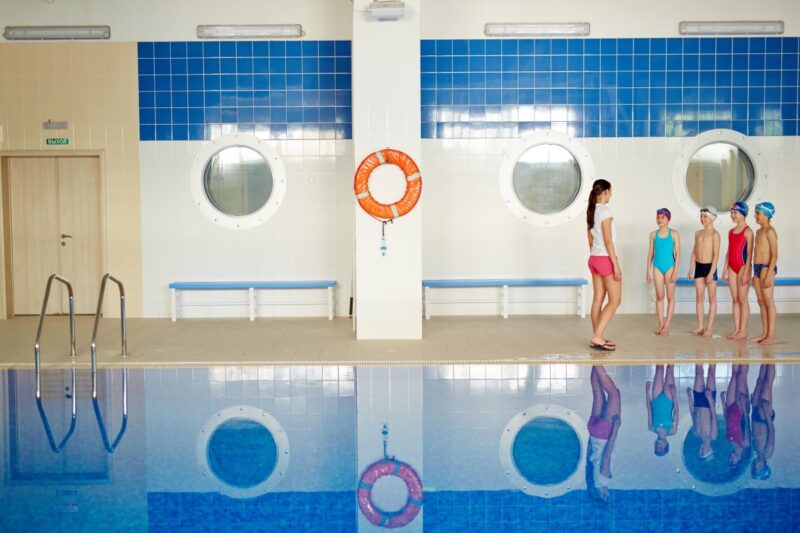
Preparing your child to try something new can be hard, even more so if your child has a special need. Children with Autism are naturally curious about their surroundings and wander off, which can make bodies of water such as lakes and pools dangerous. However, swimming can also be an enjoyable and therapeutic experience.
Rachel Chadwick is a professional swim instructor with years of experience teaching children with special needs. Here are some tips to prepare your child with Autism for their swim lesson!
1. Autism & Swimming: Make Them Feel Comfortable
Watch videos of people swimming and visiting a swimming pool. Answer any questions that your child may have. Visual aids are important for a child with Autism. Videos and having a conversation with your child give them an idea of what they will be doing during a lesson.
“Visiting a pool and meeting with an instructor having an instructor come to your home pool will help establish comfort in a new environment. Take your child through the facility and introduce them to their instructor.”
Visual aids and personal interactions go a long way when it comes to getting comfortable with swimming.
2. Autism & Swimming: Watch A Swim Lesson With Your Child
The next step to introducing swimming to your child is watching a live swim lesson. Seeing how swim lessons work up close will show your child how much fun swimming will be!
It also allows them to ask more questions and see what they will soon be doing.
3. Autism & Swimming: Visit The Pool & Ask About Their Policies
Have a meeting with the facility supervisor and ask them about their policies when providing service to a child with Autism.
These are some questions to consider asking if your child will be learning at a community pool:
- What time of day would be the least noisy for my child to have a comfortable lesson?
- What aids can be used to help my child learn? (i.e. Flutter boards, noodles, fins, etc.)
- Since my child has autism and requires extra care, is there an instructor who would be a good match for my child? (i.e. an instructor who has experience with working with children with Autism or who is studying childcare)
- Ask for a tour of the pool facility and areas around it. If your child tends to wander and there is a lot of open space, it’s best to look out for dangers and places a child can hide.
Children with Autism like a sense of routine. Asking the right questions and getting to know the pool area. Additionally, knowing what they will be learning and how will make the transition to the pool easier. Preparation is everything when it comes to making sure your child is happy when swimming.
4. Autism & Swimming: Accommodate Your Child’s Sensory Issues
Work with the instructor to accommodate your child’s sensory issues. Before getting into the water, parents should be aware of:
- Clothing Preferences: “If your child doesn’t like tight clothing such as a bathing suit, they can wear a swim shirt and shorts. They can wear a wetsuit or rash guard to prevent the feeling of water directly brushing against their skin.”
- Brightness and Water in Eyes: When swimming outside or in a bright environment, “tinted goggles can help block out the light and keep water out of our child’s eyes. Earplugs will help reduce noise as well as keep water out of their ears. Nose plugs will keep your child from accidentally inhaling water while swimming.”
- Physical Manipulation: “Sometimes swimming lessons involve physical manipulation to better teach a certain skill. If your child doesn’t like to be touched or grabbed, it’s important to inform the instructor to make the class a hands-off lesson.
Multiple factors come into play during the swimming lessons. Knowing how to keep your child comfortable is key to this. This comes into play both before and during swimming lessons. Having the right equipment and a quick chat with the instructor can make a big difference.
5. Autism & Swimming: Provide a Quiet Break Room For Your Child
A safe and comfortable space for your child during lesson time can help them progress as a swimmer. A quiet spot on the deck or away from the pool to have breaks during the lesson gives a child with Autism time to get away from the noise and stimulation of the pool.
“Sometimes the swim lesson can be overwhelming. A quiet break room gives the child a place to decompress and relax. However, it is important to emphasize the fact that the break is not a place to escape from swimming lessons. It is not a place where a child can go just because they don’t want to swim that day. It should only be used when needed,” Chadwick says.
Meet Rachel
As a recent graduate of the Educational Support program at Sheridan College, she continues to learn with a specialization in Behavioural Science. She has completed 3 different placements at various schools working in self-contained programs and integrated classrooms. During her time as a swim instructor, she has been able to coach swimmers who competed in the Special Olympics! She aims to provide students with high-quality and inclusive swim instruction.
At AquaMobile, we provide private swim lessons for all children and learners. Many of our swim instructors have specialized training and post-secondary education in Special Needs Education, Teaching and Behavioural Science. Click here to learn more about swim lessons!




